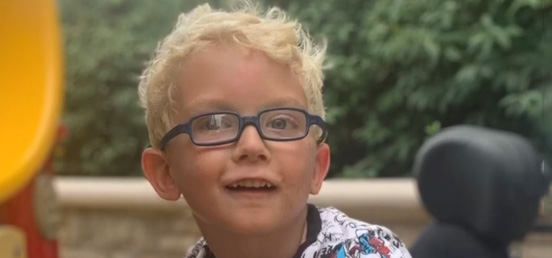
Five-year-old Asher is sleeping, walking and kicking a ball better than he was several months ago – and not simply because these are things that improve as most kids get older. For Asher, it’s thanks to a decision his parents made to have a specialized neurosurgical procedure at CHoR.
Learning about a selective dorsal rhizotomy
Asher has spastic diplegic cerebral palsy, a condition that results from brain injury at birth. It causes increased muscle tone, weakness and difficulty with movement in the legs. Most kids, including Asher, are treated with Botox, physical therapy and medications, but his parents were looking for a way to limit frequent treatments that made Asher anxious and improve his quality of life. That’s when their doctor at another children’s hospital recommended selective dorsal rhizotomy with Dr. Ann Ritter.
Selective dorsal rhizotomy is usually recommended for kids with spasticity due to cerebral palsy who are already good walkers but want to make their walking better. The three-to-five-hour procedure involves cutting some of the sensory nerves so not all the brain’s sensory inputs go out to the muscles. In a person without cerebral palsy, the brain inhibits some of these messages on its own. In addition to reducing reliance on Botox and medications and improving gait, selective dorsal rhizotomy will also decrease the number of future procedures Asher may need such as tendon lengthening.
Traveling to CHoR for the right care
Asher’s mom read stories of families traveling 10 plus hours to hospitals that specialize in this type of surgical treatment. Luckily for Asher and his family, Dr. Ritter was just a two-hour drive down the interstate. When they met Dr. Ritter, her knowledge and obvious dedication to Asher’s best interests set his mom at ease.
“Her demeanor, her wherewithal, her confidence in what she’s doing said everything to me that she’s got my child’s best interests in the palm of her hands and she’s going to take care of him,” said Asher’s mom, Julie.
Asher had his selective dorsal rhizotomy on July 14, 2021 and after a couple days recovering in the hospital is back to doing all his favorite things and more. While he’s returned to seeing his physical medicine and rehabilitation specialist closer to home, he continues to have follow-up visits with Dr. Ritter to check in on his progress following surgery.
“His overall ability to do things has just gotten better. He walks taller, he stands taller and with less of a lean,” added Julie.
A neurosurgeon with a passion for helping kids and families
For Dr. Ritter, the relationship not only with each patient, but their parents as well, is part of why she chose to specialize in pediatric neurosurgery. It’s also why patients from across the east coast have traveled to see her for the same and similar surgeries. She consults with their referring physicians and coordinates care to help them get increasingly stronger and more flexible after they return home.
“It feels great to see Asher with the improvement in his running and his sleeping at night is more comfortable and he’s able to kick a ball now,” said Dr. Ritter. “That’s why I picked pediatric neurosurgery. Not only do I get to help the patient, but mom is so excited to see all the things her son wasn’t doing before.”
